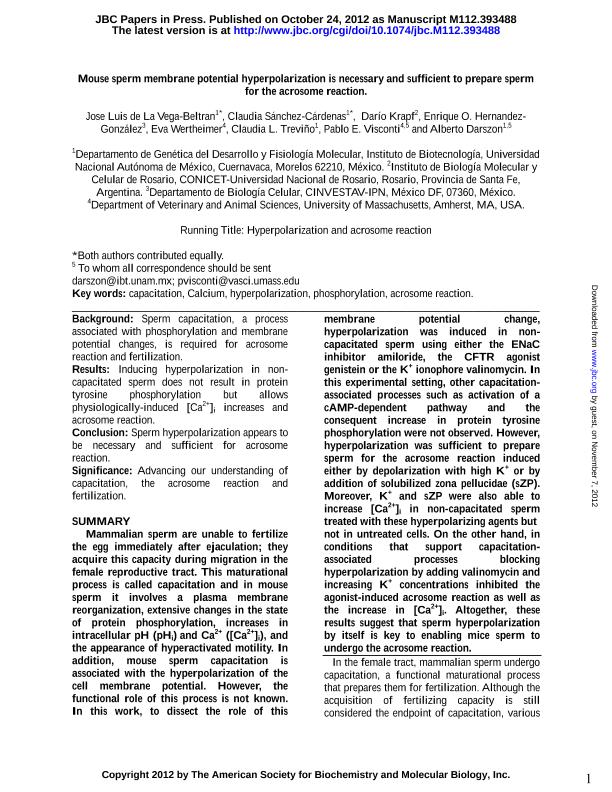Artículo
Mouse sperm membrane potential hyperpolarization is necessary and sufficient to prepare sperm for the acrosome reaction
de La Vega Beltrán, José Luis; Sánchez Cárdenas, Claudia; Krapf, Dario ; Hernández González, Enrique; Wertheimer Hermitte, Eva Victoria
; Hernández González, Enrique; Wertheimer Hermitte, Eva Victoria ; Trevinio, Claudia L.; Visconti, Pablo E.; Darszon, Alberto
; Trevinio, Claudia L.; Visconti, Pablo E.; Darszon, Alberto
 ; Hernández González, Enrique; Wertheimer Hermitte, Eva Victoria
; Hernández González, Enrique; Wertheimer Hermitte, Eva Victoria ; Trevinio, Claudia L.; Visconti, Pablo E.; Darszon, Alberto
; Trevinio, Claudia L.; Visconti, Pablo E.; Darszon, Alberto
Fecha de publicación:
12/2012
Editorial:
American Society for Biochemistry and Molecular Biology
Revista:
Journal of Biological Chemistry
ISSN:
0021-9258
Idioma:
Inglés
Tipo de recurso:
Artículo publicado
Clasificación temática:
Resumen
Mammalian sperm are unable to fertilize the egg immediately after ejaculation; they acquire this capacity during migration in the female reproductive tract. This maturational process is called capacitation and in mouse sperm it involves a plasma membrane reorganization, extensive changes in the state of protein phosphorylation, increases in intracellular pH (pHi) and Ca2+ ([Ca2+]i), and the appearance of hyperactivated motility. In addition, mouse sperm capacitation is associated with the hyperpolarization of the cell membrane potential. However, the functional role of this process is not known. In this work, to dissect the role of this membrane potential change, hyperpolarization was induced in noncapacitated sperm using either the ENaC inhibitor amiloride, the CFTR agonist genistein or the K+ ionophore valinomycin. In this experimental setting, other capacitation-associated processes such as activation of a cAMP-dependent pathway and the consequent increase in protein tyrosine phosphorylation were not observed. However, hyperpolarization was sufficient to prepare sperm for the acrosome reaction induced either by depolarization with high K+ or by addition of solubilized zona pellucida (sZP). Moreover, K+ and sZP were also able to increase [Ca2+]i in non-capacitated sperm treated with these hyperpolarizing agents but not in untreated cells. On the other hand, in conditions that support capacitation-associated processes blocking hyperpolarization by adding valinomycin and increasing K+ concentrations inhibited the agonist-induced acrosome reaction as well as the increase in [Ca2+]i. Altogether, these results suggest that sperm hyperpolarization by itself is key to enabling mice sperm to undergo the acrosome reaction.
Archivos asociados
Licencia
Identificadores
Colecciones
Articulos(CEFYBO)
Articulos de CENTRO DE ESTUDIOS FARMACOLOGICOS Y BOTANICOS
Articulos de CENTRO DE ESTUDIOS FARMACOLOGICOS Y BOTANICOS
Articulos(IBR)
Articulos de INST.DE BIOLOGIA MOLECULAR Y CELULAR DE ROSARIO
Articulos de INST.DE BIOLOGIA MOLECULAR Y CELULAR DE ROSARIO
Citación
de La Vega Beltrán, José Luis; Sánchez Cárdenas, Claudia; Krapf, Dario; Hernández González, Enrique; Wertheimer Hermitte, Eva Victoria; et al.; Mouse sperm membrane potential hyperpolarization is necessary and sufficient to prepare sperm for the acrosome reaction; American Society for Biochemistry and Molecular Biology; Journal of Biological Chemistry; 287; 53; 12-2012; 44384-44393
Compartir
Altmétricas



